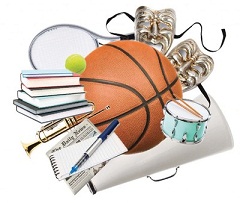
Public school students across the United States (US) participate in a wide variety of extracurricular activities like interscholastic and intramural athletic programs; service and school government clubs; music, art and drama organizations and academic and vocational clubs. Generally, conducted outside the normal school day, activities are voluntary and students do not receive grades for their participation.
Benefits for Students:
Do these clubs, teams and organizations support the academic mission in schools? In a paper looking at predictors of academic found that students emerge to spend their time-out of school participating in constructive activities. The research disclosed that 50 % of students were connected to involve in extra-curricular activities.
Involvement in extracurricular activities is beneficial for students. Busy in school extracurricular activities is linked to decreasing rates of early school dropouts in both boys as well as girls. It is discovered that such type of participation provides marginal students an opportunity to create a positive also voluntary connection to their school. Equally, other strategies typically used to address the requirements of students, like school dropout anticipation programs and remedial education focus on the deficits of students and serve as a catalyst in the formation of deviant groups. The researchers believe that involvement in extracurricular activities may support the student by enhancing, maintaining and strengthening the student-school connection.
Raising Academic and Social Skills:
Various kinds of activities have varying abilities to control school dropout rates. It is concluded that students who participate in fine-arts activities, athletics and academic organizations were an estimated less compared to drop out than those who didn't participate. Athletic participation decreases the probability of school dropouts by approximately 40 percent.
The academic improvement of students who participated in extracurricular activities looked at male moreover female in high school students that participated in interscholastic soccer and who did not engage in another sport or major activity at the conclusion of the soccer season. They discovered that female participants maintained a GPA. The girls earned higher GPAs than did the boys but the boy's GPAs rose significantly. The study supports the belief that involvement in athletics for high school students doesn't endanger and may enhance academic performance.
Extracurricular participation is not detrimental to student performance whereas participation in these types of activities promotes greater academic achievement. Additionally, it is discovered that participation in school connected activities was more strongly associated with achievement than was participation in activities outside the school.
Participating for Success:

All the cited research suggests that extracurricular activities offer all students an academic safety net. Eliminating the opportunity for such type of participation eliminates the last link to fostering a sense of belonging to school which some of the students have.
Educational decision makers must look at the consequences of denying students that right to participate in order to get them to "work harder in the classroom." These types of exclusionary strategy may well damage overall achievement also work against those students who could benefit most directly from involvement. Instead of cutting these types of programs when faced with budget squeezes school districts might find that these activity programs are worth their weight in gold since they help student stay in and succeed at school.
Even though many schools have playgrounds, baseball or softball fields, general-purpose fields, outdoor tracks, outdoor basketball courts, soccer fields, swimming pools, fitness areas, or indoor gymnasiums, that might provide limited liability protections specific to activities performed on these facilities. Recreational facilities to members of the community outside of regular school hours are suggested.
The power of sports:
Athletic programs suggest a simple and powerful solution. Students must required physical exercise also they like to play games. They wish for the kind of social interaction and adult mentoring that comes from being part of a team. Athletic programs provide students a direct incentive to attend school also keep up their grades and graduate with their classmates.
Advantages and Disadvantages of Sports at Schools:
Sports in school are a good thing so long as they don't take precedence over academics. Having sports at school is for the most part viewed as a good thing as it gives youths opportunities to learn teamwork, get fit and do something constructive with their spare time. Nevertheless, there are so many drawbacks. From time to time sports at schools can either directly or indirectly affect behaviour and grades in a bad way.
Physical Fitness:
Getting in shape is never a bad thing however it is even more important these days because of a well-documented rise in childhood obesity. The best thing about sports at schools is that children can do something fun as they get in shape, as opposed to adopting a rigorous, high-pressure exercise regimen. Even if gruelling exercise is required for the sport the student-athlete plays, it will be a means to an end in that she's doing it to get better at the sport she enjoys.
Poor Academic Performance:
If sports at schools be converted into too much of a focus then getting good grades can take a back seat. All too regularly star athletes study just enough to earn their eligibility as opposed to studying to learn or prepare for a career. Also, in worst case scenarios teachers may rank athletes easier to keep them play. Sports at schools are an overall good thing, but not when the sports take precedence over education.
Conclusion:
Such activities as school newspaper and interschool sports programs have been part of American high schools since the World War I era. Today's public high schools offer a comprehensive array of extracurricular activities to complement the curriculum. Companies seeking job applicants may not look solely for those with a high GPA, workers might also look at extracurricular activities to describe if the applicant is the best suited for the job.